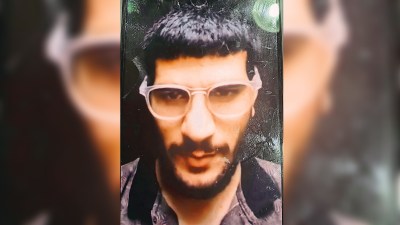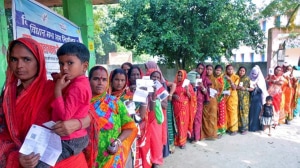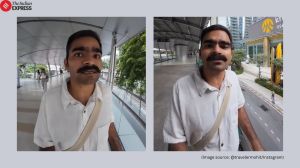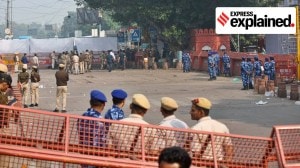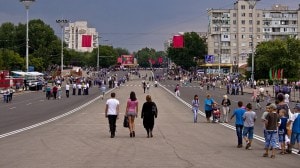Telangana split over ‘Liberation’ vs ‘Integration’ Day, Maharashtra set to mark Marathwada ‘Liberation Day’
On Sept 17, both states will commemorate 75th anniversary of the annexation of the princely state of Hyderabad
 People pose for photographs in front of a 'chitra rath' (chariot) adorned with images and the message 'Marathwada Muktisangram' which translates to Marathwada 'Liberation Day', in Latur. (PTI)
People pose for photographs in front of a 'chitra rath' (chariot) adorned with images and the message 'Marathwada Muktisangram' which translates to Marathwada 'Liberation Day', in Latur. (PTI) On September 17, while the ruling Bharat Rashtra Samithi (BRS) in Telangana will mark ‘National Integration Day’ to commemorate the annexation of the Nizam-ruled Hyderabad state by India in 1948, the BJP will celebrate it as ‘Hyderabad Liberation Day’, to frame the annexation as a movement against the Nizam of Hyderabad.
In neighbouring Maharashtra, the same day is celebrated, without much difference between parties, as Marathwada Mukti Sangram Day or Marathwada Liberation Day.
The erstwhile Hyderabad princely state included regions now spread over Karnataka and Maharashtra, apart from Telangana.
 India’s southern princely states: After its annexation, the Hyderabad princely state was split and merged with three other states – Andhra Pradesh, Maharashtra and Telangana. The regions of the state west of red and blue lines merged with Maharashtra and Karnataka states and the rest was merged with Andhra. (Source: Wikimedia Commons)
India’s southern princely states: After its annexation, the Hyderabad princely state was split and merged with three other states – Andhra Pradesh, Maharashtra and Telangana. The regions of the state west of red and blue lines merged with Maharashtra and Karnataka states and the rest was merged with Andhra. (Source: Wikimedia Commons)
Until last year, September 17 was marked by functions in each of the eight districts of Marathwada, in eastern Maharashtra, with the Chief Minister presiding over the function in Aurangabad.
After the BJP came to power following a split in the Shiv Sena in July 2022, it announced bigger, year-long celebrations to mark Marathwada Liberation Day, leading up to the 75th anniversary that falls coming Sunday.
The Eknath Shinde-led government set up a committee of ministers from the Marathwada region to plan public events and meetings throughout the year. On September 11, a ‘Krantishali Rath’ took off from Latur to raise awareness about the “Marathwada freedom struggle”. A ‘chitra rath’ (chariot) has also been flagged off which has been broadcasting a film on the struggle.
September 15 to 17 will see cultural programmes in each of the eight districts of the region, including processions and flag-hoisting ceremonies. On September 16, a special Cabinet meeting will be held in Aurangabad, where the state government is expected to announce development measures.
The same day, Union Home Minister Amit Shah will attend the main programme for the Marathwada Day celebrations; a day later, he will be in Hyderabad to preside over the BJP’s celebrations of ‘Telangana Liberation Day’.
The state government’s celebrations, though, have been somewhat marred over the renewed demand for Maratha reservation, with protests centred in Marathwada. Aware of the repercussions of the protest, the Shinde government has announced that Kunbi caste certificates will be issued to the Marathas from the Marathwada region who possess revenue or education documents from the Nizam era which recognise them as Kunbis.
Kunbis enjoy reservation benefits under the OBC category.
However, the move is hardly going down smoothly, with the OBCs threatening agitation if their share reduces due to the entry of the Marathas among them. At 33%, the Marathas are the largest group in the state, and have always held political clout.
Political parties
Unlike Telangana, where parties dictated by their politics differ over the nomenclature and symbolism of the merger of the Hyderabad state with India, in Maharashtra, all parties are one on the issue. While the population of Muslims in the Marathwada region is estimated to be around 15%, in Telangana, the Hyderabad state area has around 12.7% Muslims among its population.
In Telangana, the entry of the BJP into the picture has heated up politics over the issue, especially the semantics of what to call the day. The ruling BRS’s alliance with the AIMIM, whose origins lie in the Nizam regime and which is based in Hyderabad, makes it an easy target for the BJP.
Aurangabad, the heart of Marathwada, meanwhile, has also lately emerged as a battleground as the BJP pushes its Hindutva narrative in a region that bears the name of Mughal Emperor Aurangzeb and where the AIMIM is a growing force.
Sensing that the BJP was threatening to run away with the Marathwada Liberation narrative by scaling up the September 17 celebrations, parties in the opposition, including the NCP’s Ajit Pawar, the Shiv Sena (UBT)’s Aaditya Thackeray and the Congress’s Nana Patole, demanded earlier this year that the government “celebrate Marathwada Liberation Day in a grand manner”.
Now, there is a new party in town. In its bid to grow beyond Telangana, the BRS led by Chief Minister K Chandrashekar Rao has been making forays into the erstwhile Nizam area in Maharashtra.
Previous demands
In 2016, when the Devendra Fadnavis-led BJP government was in power, the state’s Advocate General, Shreehari Aney, was forced to resign after his call for a separate Marathwada state in his personal capacity ran into protests by the Congress, NCP and Shiv Sena. An advocate of smaller states, Aney had also called for an independent Vidarbha region.
There is no larger public movement though in favour of statehood in these regions.
Calling the demand “illogical”, former Congress CM Ashok Chavan had said at the time: “Our forefathers sacrificed their lives for a united Maharashtra. Development in Marathwada definitely has a long way to go, but at least it has got constitutional rights that ensure earmarked funds for development. The region has its challenges, but separation is definitely not a solution.”
Marathwada freedom struggle
After India gained Independence in 1947, the princely states were given the choice of joining either India or Pakistan. The erstwhile Nizam of Hyderabad, Mir Osman Ali Khan, sought to remain independent. However, locals in Marathwada preferred joining the Indian union, leading to a revolt led by prominent social thinkers and reformers like Swami Ramanand Tirtha, Govindbhai Shroff, P H Patwardhan, Vijayendra Kabri and Ramanbhai Parikh.
At the time, within Hyderabad, a three-way tussle was underway between the Nizam, the Hyderabad State Congress and Communist groups, historian Ramachandran Guha writes in ‘India After Gandhi’. The Nizam was supported by the Majlis-e-Ittehadul Muslimeen (the precursor to the AIMIM) and its paramilitary wing called the Razakars. While the Nizam refused to sign the Instrument of Accession with India, he agreed to a ‘Standstill Agreement’ in November 1947, to maintain the status quo for the time being.
But as the months wore on, the Nizam and the government were unable to reach an agreement. In the meantime, the influence of the extremist Razakars grew stronger, Hindu-Muslim tensions rose and a Communist uprising added to the state’s instability.
In Marathwada, locals took up arms against the Razakars. Hingoli district in particular saw severe clashes, leading to the death of freedom fighter and local leader Bahirji Shinde. Swami Ramanand Tirtha was key in unifying Marathwada’s farmers and connecting the local movement to the national Independence struggle, writes historian Arunansh Goswami.
In September 1948, the Indian government decided to take direct action and sent the Army into Hyderabad, infiltrating through Solapur and taking control of areas in Naldurg, Tuljapur, Parbhani, Gadchandur and Kanergaon – all towns in present-day eastern Maharashtra.
It took just four days for the Indian Army’s ‘Operation Polo’ to take Hyderabad. Estimates suggest 42 Indian soldiers and more than 2,000 Razakars died in the fighting. During the invasion, communal violence also led to anywhere between 30,000 and 2 lakh civilian deaths. On September 17, the Nizam officially surrendered. He called for a ceasefire and banned the Razakars, whom he later blamed for forcing him to keep Hyderabad independent.
On September 18, Operation Polo was terminated and Hyderabad, including Marathwada, was absorbed into India.
The irony is that all these years later, while it is back in the news due to a new turn in politics, Marathwada is among the most backward regions of Maharashtra.



- 01
- 02
- 03
- 04
- 05


